Apple iPad mini with Retina Display: Reviewed
by Anand Lal Shimpi on November 16, 2013 8:00 AM ESTThe SoC
The iPad mini with Retina Display rounds out the three platforms that use Apple’s A7 SoC. Although both the iPad Air and iPhone 5S use the A7, the mini’s implementation is closer in nature to the iPhone. The iPad mini’s SoC has always used the same package-on-package (PoP) assembly as the iPhone, with DRAM stacked on top of the SoC itself (1GB in this case). The benefit is obviously a reduction in board area, the downsides have to do with cost and thermals. That’s the first similarity between the mini’s A7 and the iPhone’s A7.
The second is one of frequencies. While the iPad Air’s A7 runs its two Cyclone CPU cores at up to 1.4GHz, the SoC in the iPad mini and the iPhone 5S runs at up to 1.3GHz. That might sound like a minor difference, but it’s far more pronounced when you look at what happens to frequency when you’re running heavy workloads.
Once again I turn to a fairly heavy CPU workload to plot performance over time. This is a multithreaded workload, slightly modified from what we used in the iPad Air review, designed to make the CPU cores consume max power. The scale is linear and the workload is the same across all devices, so what you’re effectively looking at is a graph of thermally bound CPU performance over time across all three A7 implementations:
Being the largest device (and the only device with a metal heat spreader and no DRAM stacked on top), the iPad Air obviously maintains the highest frequencies for the duration of the test. The iPhone 5S, with a significant reduction in internal volume (and a PoP SoC) reduces its CPU frequencies early on in order to keep skin temperature down and properly manage thermals. The iPad mini with Retina Display falls between the two, with its performance curve more closely following that of the iPhone 5S.
Although the mini has a similar max operating frequency to the iPhone 5S, it is a faster device thanks to it being less thermally constrained. Similarly, the iPad Air can be much faster than its clock speed would otherwise imply. If you’re wondering why Apple has been so focused on building its own SoCs and CPU architectures, this is the reason why. There’s a fixed amount of power you can dissipate in the form of heat in these mobile devices while still maintaining a good user experience. Performance per watt is the gating metric for success in mobile, and shipping high IPC/low frequency dual-core SoCs at 32/28nm is the best optimization available to a company like Apple today.
As you’d expect, our browser based CPU tests show the mini’s A7 performing in between the iPhone 5S and iPad Air. None of these tests are anywhere near as stressful as our thermal test from above, so we don’t see exaggerated differences in performance between the platforms. For most, I suspect you won’t notice a huge performance difference between the mini and Air. Those who are heavier users (e.g. audio mixing, 3D gaming, etc…), there will be a performance difference between the two iPads.
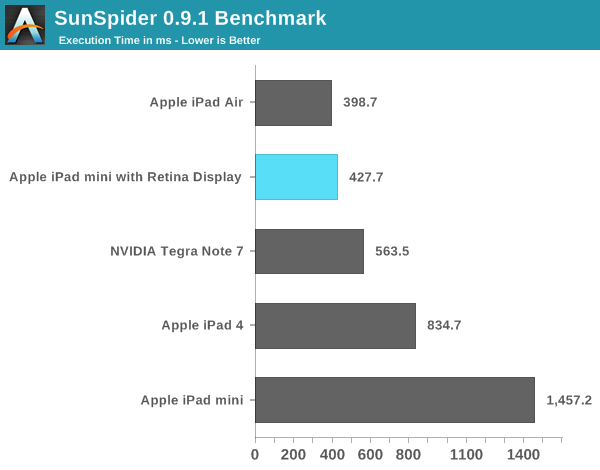

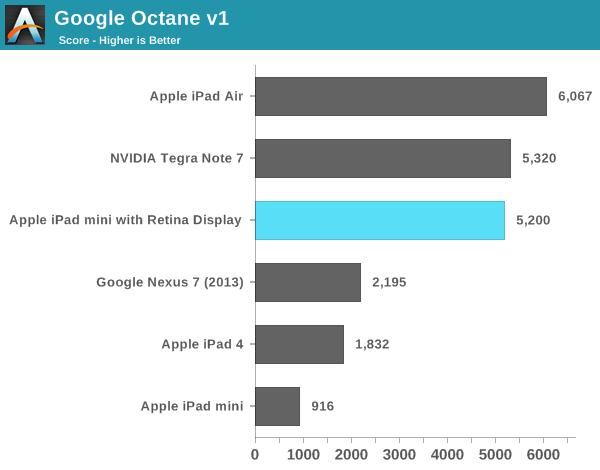
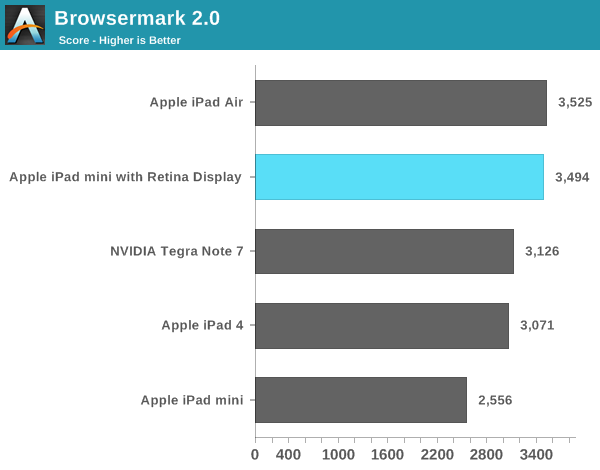
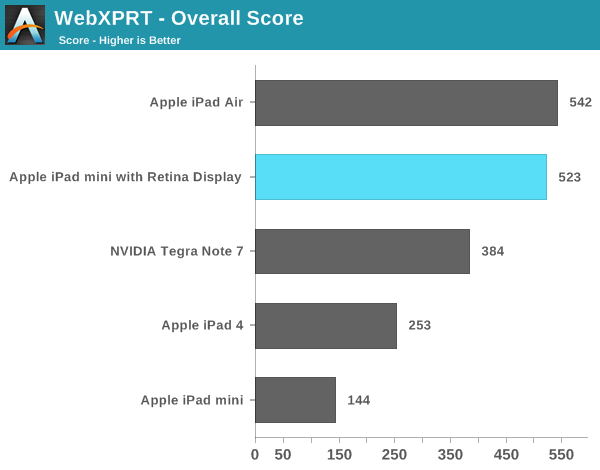
Compared to the first generation iPad mini, the new model is in a completely different performance league. Keep in mind the first mini used Apple’s A5 SoC based on an ARM Cortex A9. That’s the same single threaded performance as what’s in an iPhone 4S, and under iOS 7 it’s clearly running into some performance limits. The new mini with Retina Display however is a completely different animal. It’s fast.
Even comparing to the 4th generation iPad, the new mini is noticeably quicker.
Memory Bandwidth
Looking at the iPad mini’s memory bandwidth curve, we see it tracks very closely with that of the iPhone 5S. This is a slightly modified version of our previous bandwidth test, and you can see peak usable memory bandwidth (from the CPU’s perspective) of around 10GB/s. The ~12GB/s area right before you get out to main memory is bandwidth to the A7’s 4MB system-wide cache that sits after the shared L2 and the memory controller. This cache appears to service CPU, GPU and ISP requests at least.
GPU Performance
I believe the A7’s PowerVR G6430 GPU runs at around 450MHz. This frequency appears unchanged across all three A7 implementations. Once again, the big difference is how much thermal headroom exists in the platform which has an impact on overall performance.
Kishonti’s low level GPU performance tests back up my assertion that GPU frequency is fixed across all A7s. The iPad mini with Retina Display delivers equal performance to the iPad Air. The bigger news here is that nearly all of the GPU bound 3D tests seems to peg the mini and Air as equals. These are some pretty intense tests, but it looks like on the GPU side there’s no significant throttling when running at full tilt.
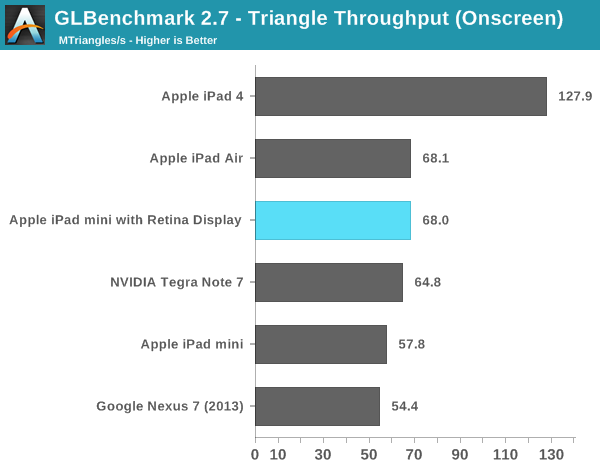

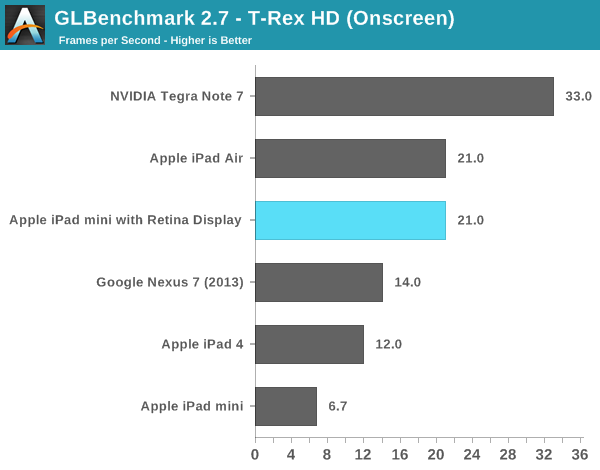

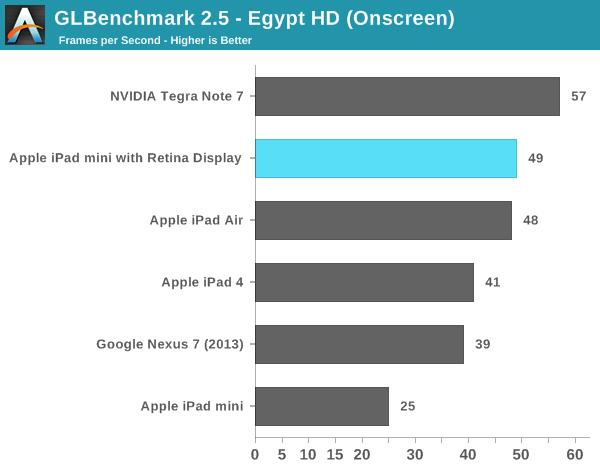
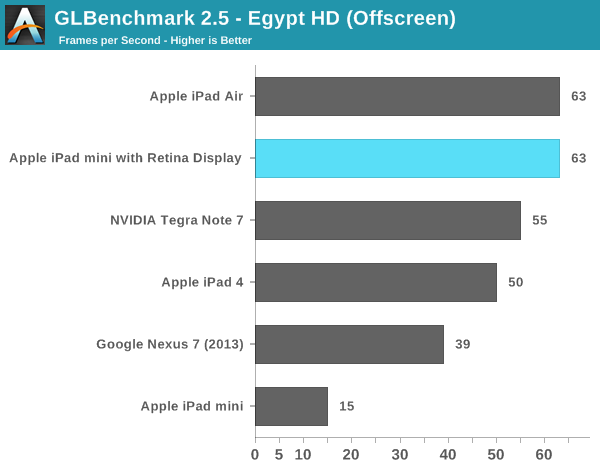
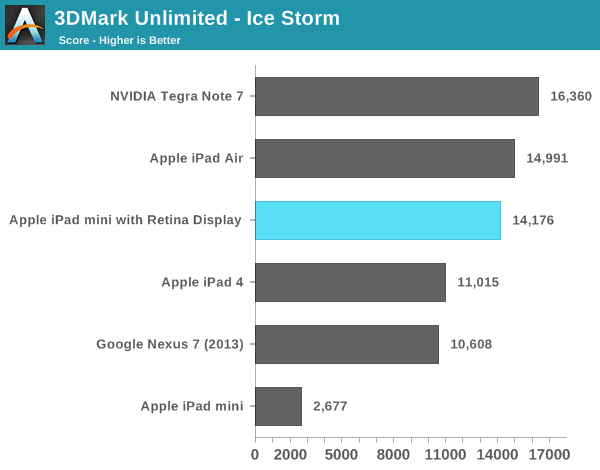
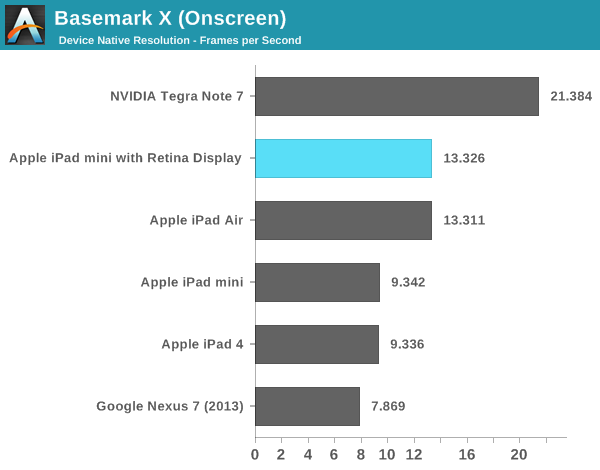
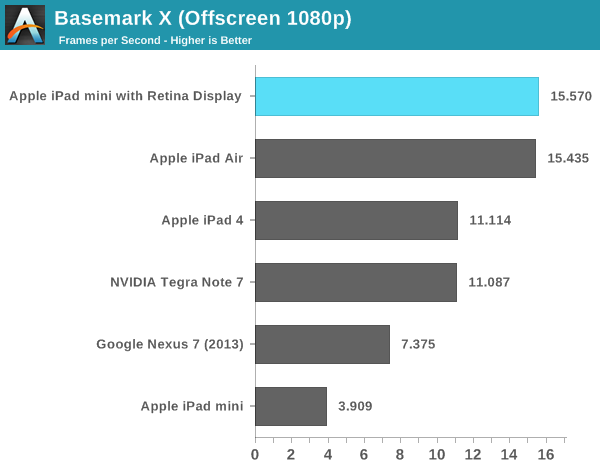
As I mentioned in our iPad Air review, despite having less peak theoretical memory bandwidth than the A5X/A6X, the A7 in the iPad mini never seems to regress in performance compared to even the iPad 4. Across the board the mini appears to be faster, more responsive and have more performance on tap than any prior iPad (big or small). The comparison to the original iPad mini is of course night and day. Even looking at lighter tests like the old GLBench Egypt HD benchmark, the iPad mini with Retina Display manages to be nearly twice as fast as the original mini - all while rendering 4x the number of pixels.


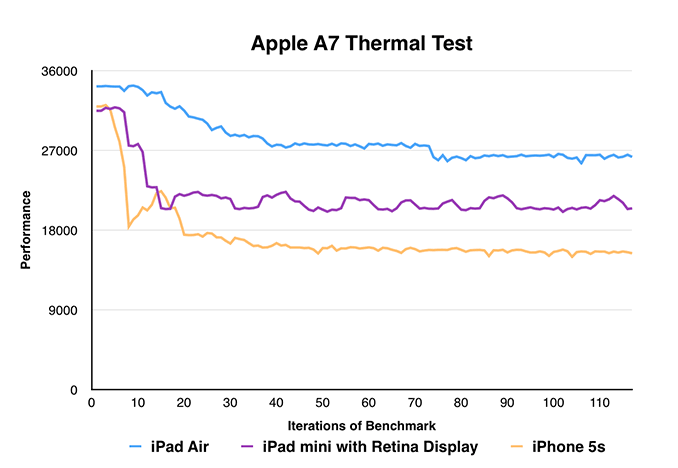
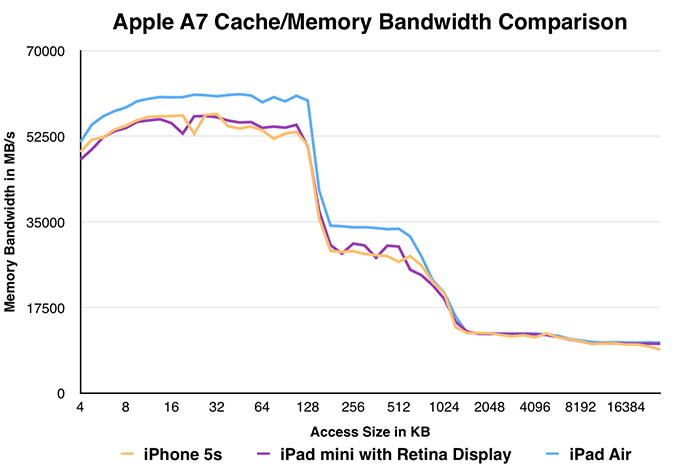








345 Comments
View All Comments
KPOM - Sunday, November 17, 2013 - link
If it is an astroturf campaign, it isn't working. If anything, it makes the criticisms sound shrill. There are valid criticisms of the iPad mini and other Apple devices, but they get lost among all the clutter.julandorid - Sunday, November 17, 2013 - link
Actually, the final rating is pretty accurate! The review mention all of the important flaws as the quality of the display which is still decent but not quite as good as it is on the Nexus 7. Also a very important thing is the price. The author of this review is not convinced that (double) price is justified anyhow. Actually the contrary. He practically encourage the buyers to take the Nexus 7 in serious consideration.My personal opinion is the display is not that bad as it is described, but it is entirely a conscious decision made by Apple to calibrate the display with much lower brightens in order to achieve a good battery and correct gamma. If they decided to put an extra power to the led backlight and does a different calibration then I guess we would have a better screen but in the expense of pretty bad battery life. Apple did a smart move by offering great performance and good battery life. Probably no body will notice the display since it is already better (I mean sharper) that it was previously. That gives Apple another chance, next year to advertize an even better iPad mini.
The only serious concern that I have is the price! It is a known fact for years that Apple never rise the price (because it is already too high anyway) and always keep it the same while refreshing the product's internal and external components with better ones. However this year they decided to do the opposite - to increase the price even further.
So, for me was no brainer to go with the new Nexus 7. Great device, great display. I always smile when I look at it.
KPOM - Sunday, November 17, 2013 - link
I think Apple raised the price partly because they knew demand would outstrip supply. Also, the price increase makes the iPad Air pricing seem a bit more reasonable. I wouldn't be surprised to see it drop back down to $379 or $349 with next year's launch when the displays will be more plentiful.Regarding Google and Amazon pricing, they will always undercut Apple because their business models are different. Amazon sells the devices close to cost because they want to sell you content. Google does the same because they make their revenue from ads. Therefore, comparable Apple and Samsung devices will always be pricier.
RadarTheKat - Monday, November 18, 2013 - link
Every tablet has two prices. The new price and the resale price. You mentioned only the first.joe mann - Sunday, November 17, 2013 - link
GLONASS, where it went in rIPad mini, or Air?KPOM - Sunday, November 17, 2013 - link
I think it is still there, just not publicized. On MacRumors, people have posted the Russian pages which appear to indicate support for GLONASS.EOL - Sunday, November 17, 2013 - link
Excellent review.One point: you mention not being able to comfortably use your thumbs to type with the iPad Air in portrait mode. But did you use the built-in split keyboard or the full keyboard? Using the split keyboard (obtained by pulling both sides of the regular keyboard towards their edge) makes typing with the thumbs much easier.
R0H1T - Sunday, November 17, 2013 - link
@ akdjSadly brain dead morons like you think that every negative comment about your fav device, no its not a "computer" period, is by a kid living at his parents' place & frowning over his friend's latest shiny little iToy. Unfortunately for people like you, with enough cash to burn on these entertainment/computing devices, the fact that someone points out that they obviously overpaid for such hardware is a tough pill to swallow & thus fandroid or Dbags is what they'll resort to, tit for tat I guess !
Also the comment system on AT sucks as my previous response was supposed to be a reply to someone else's comment however people will still continue to frown over this without taking into context the original post.
pedrostee - Sunday, November 17, 2013 - link
this was particularly moronicDennis Travis - Sunday, November 17, 2013 - link
Why if you feel Anand and his staff are unfair and Apple lovers and tell lies in their reviews, do you bother even coming here and reading his excellent reviews? If I feel someone is unfair, I won't even bother reading anything they write. I come here because I feel Anand and company are very fair and very knowledgeable and write a fair review that tells me all I need to know about what they are reviewing. If people don't agree, go to another site. You might find though if you dig a bit a lot of the others do what you are accusing Anand of doing! :DHave a good day.